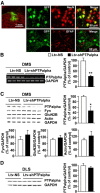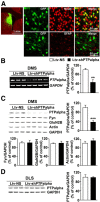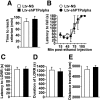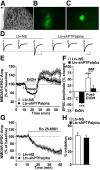Protein tyrosine phosphatase α in the dorsomedial striatum promotes excessive ethanol-drinking behaviors
- PMID: 24005290
- PMCID: PMC3761047
- DOI: 10.1523/JNEUROSCI.1954-13.2013
Protein tyrosine phosphatase α in the dorsomedial striatum promotes excessive ethanol-drinking behaviors
Erratum in
- J Neurosci. 2015 Dec 9;35(49):16295-6
Abstract
We previously found that excessive ethanol drinking activates Fyn in the dorsomedial striatum (DMS) (Wang et al., 2010; Gibb et al., 2011). Ethanol-mediated Fyn activation in the DMS leads to the phosphorylation of the GluN2B subunit of the NMDA receptor, to the enhancement of the channel's activity, and to the development and/or maintenance of ethanol drinking behaviors (Wang et al., 2007, 2010). Protein tyrosine phosphatase α (PTPα) is essential for Fyn kinase activation (Bhandari et al., 1998), and we showed that ethanol-mediated Fyn activation is facilitated by the recruitment of PTPα to synaptic membranes, the compartment where Fyn resides (Gibb et al., 2011). Here we tested the hypothesis that PTPα in the DMS is part of the Fyn/GluN2B pathway and is thus a major contributor to the neuroadaptations underlying excessive ethanol intake behaviors. We found that RNA interference (RNAi)-mediated PTPα knockdown in the DMS reduces excessive ethanol intake and preference in rodents. Importantly, no alterations in water, saccharine/sucrose, or quinine intake were observed. Furthermore, downregulation of PTPα in the DMS of mice significantly reduces ethanol-mediated Fyn activation, GluN2B phosphorylation, and ethanol withdrawal-induced long-term facilitation of NMDAR activity without altering the intrinsic features of DMS neurons. Together, these results position PTPα upstream of Fyn within the DMS and demonstrate the important contribution of the phosphatase to the maladaptive synaptic changes that lead to excessive ethanol intake.
Figures










Similar articles
-
Striatal-enriched protein tyrosine phosphatase regulates the PTPα/Fyn signaling pathway.J Neurochem. 2015 Aug;134(4):629-41. doi: 10.1111/jnc.13160. Epub 2015 May 25. J Neurochem. 2015. PMID: 25951993 Free PMC article.
-
Ethanol-induced increase in Fyn kinase activity in the dorsomedial striatum is associated with subcellular redistribution of protein tyrosine phosphatase α.J Neurochem. 2011 Nov;119(4):879-89. doi: 10.1111/j.1471-4159.2011.07485.x. Epub 2011 Oct 11. J Neurochem. 2011. PMID: 21919909 Free PMC article.
-
Inhibition of striatal-enriched tyrosine phosphatase 61 in the dorsomedial striatum is sufficient to increased ethanol consumption.J Neurochem. 2014 Jun;129(6):1024-34. doi: 10.1111/jnc.12701. Epub 2014 Mar 27. J Neurochem. 2014. PMID: 24588427 Free PMC article.
-
Regulation of NMDA receptors by the tyrosine kinase Fyn.FEBS J. 2012 Jan;279(1):12-9. doi: 10.1111/j.1742-4658.2011.08391.x. Epub 2011 Dec 5. FEBS J. 2012. PMID: 21985328 Review.
-
[Regulation of NMDA receptor function by Fyn-mediated tyrosine phosphorylation].Nihon Shinkei Seishin Yakurigaku Zasshi. 2002 Oct;22(5):165-7. Nihon Shinkei Seishin Yakurigaku Zasshi. 2002. PMID: 12451687 Review. Japanese.
Cited by
-
Targeting the intracellular signaling "STOP" and "GO" pathways for the treatment of alcohol use disorders.Psychopharmacology (Berl). 2018 Jun;235(6):1727-1743. doi: 10.1007/s00213-018-4882-z. Epub 2018 Apr 14. Psychopharmacology (Berl). 2018. PMID: 29654346 Free PMC article. Review.
-
Alcohol-dependent molecular adaptations of the NMDA receptor system.Genes Brain Behav. 2017 Jan;16(1):139-148. doi: 10.1111/gbb.12363. Genes Brain Behav. 2017. PMID: 27906494 Free PMC article. Review.
-
Mechanisms of Neuroplasticity and Ethanol's Effects on Plasticity in the Striatum and Bed Nucleus of the Stria Terminalis.Alcohol Res. 2015;37(1):109-24. Alcohol Res. 2015. PMID: 26259092 Free PMC article.
-
mTORC1-dependent translation of collapsin response mediator protein-2 drives neuroadaptations underlying excessive alcohol-drinking behaviors.Mol Psychiatry. 2017 Jan;22(1):89-101. doi: 10.1038/mp.2016.12. Epub 2016 Mar 8. Mol Psychiatry. 2017. PMID: 26952865 Free PMC article.
-
Molecular mechanisms underlying alcohol-drinking behaviours.Nat Rev Neurosci. 2016 Sep;17(9):576-91. doi: 10.1038/nrn.2016.85. Epub 2016 Jul 21. Nat Rev Neurosci. 2016. PMID: 27444358 Free PMC article. Review.
References
-
- Ben Hamida S, Neasta J, Lasek AW, Kharazia V, Zou M, Carnicella S, Janak PH, Ron D. The small G protein H-Ras in the mesolimbic system is a molecular gateway to alcohol-seeking and excessive drinking behaviors. J Neurosci. 2012;32:15849–15858. doi: 10.1523/JNEUROSCI.2846-12.2012. - DOI - PMC - PubMed
Publication types
MeSH terms
Substances
Grants and funding
LinkOut - more resources
Full Text Sources
Other Literature Sources
Medical
Molecular Biology Databases
Miscellaneous
